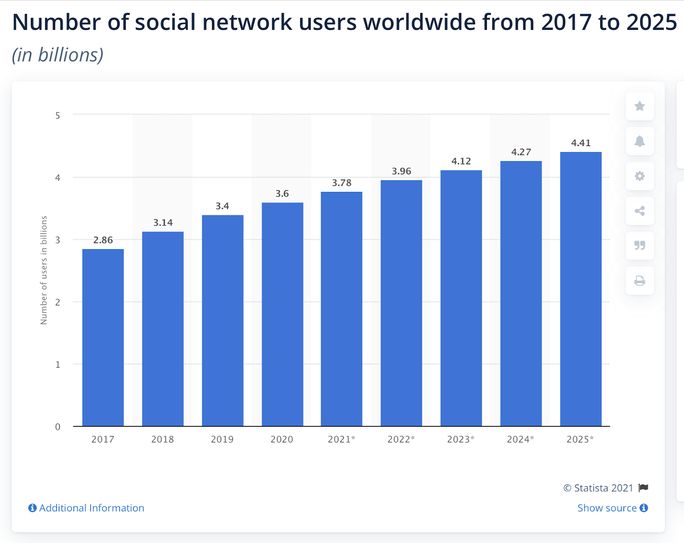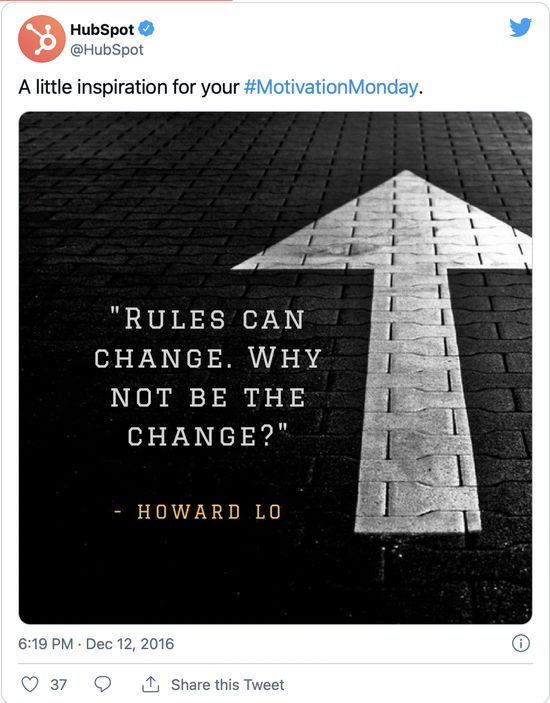We live in an online age and nothing reflects it more than social media.
According to , there are currently 3.78 billion people using social media platforms and this number may increase to 4.41 billion by 2025. In other words, using tools like Facebook, Instagram, or LinkedIn for marketing purposes becomes more and more crucial.
In this blog, I will explain what is social media marketing, and how to use it to your advantage.

What is Social Media Marketing?
The most obvious definition would be that social media marketing is a marketing strategy that involves engaging with prospects, leads and customers on social media. In its core, that is correct. Yet, I will show you that there is much more to it. In the end, around 71 % of customers with a positive experience with your business on social media are likely to recommend your brand to others.
In its beginning, social media marketing was simply about publishing relevant content on various platforms to engage with people, generate traffic to brands’ websites, etc. Now, these platforms may be used for a whole bunch of marketing activities, such as broadcasting live events, monitoring competition, or gaining statistics and valuable data about followers. Those may be used to tailor marketing strategies, based on customers’ activities, age, location, job industries, and many more.
Benefits of Social Media Marketing
I already spoiled a few of them, but let’s dig deeper into the advantages of social media platforms for your marketing efforts.
Grow Brand Awareness and Increase Traffic
The point here is simple: If people don’t know you, they cannot make a profit. First, you have to showcase that you exist. The best way to be noticed and remembered is by including visuals – such as pictures, infographics, or videos – in your social media campaigns. The fact is, our brain can process visual inputs 60,000 times faster than words. Therefore, 90 % of the information we gain is transmitted through what we see.
To increase traffic to your website, it is also important to make your content interactive. Include direct links, comments, shares, re-posting and likes into your social media marketing strategy. Ask questions and don’t forget to answer them. Have an entire team focused on social media customer service, since an average user expects the brand to respond within 10 hours.
Show your Human Face
Social media users, mainly those on less professional platforms, don’t like when the brand is pushing slogans on them. People feel the most attached to what feels personal. Messages and stories that they can identify with.
Dig deeper into your leads’ personas. Find out what they like and accommodate your social media activities to fit their environment. In short, be less of a marketer and more human. Speak their language.
Reduce the Marketing Costs
In contrast with the diversity you get out of social media marketing, this kind of promotion is extremely cost-efficient. Using social media for marketing purposes may be either completely free or – if you decide for paid ads – for a relatively low cost. Especially when compared to other paid marketing strategies. What’s more? Paid social media advertising has a high chance of fast returns on investment (ROI).
How to Make the Most Out of Social media?
After reviewing some undeniable benefits, let’s dive deeper into the most important part. How to properly use social media to your advantage? There are several crucial points you need to take into account.
1. Define Your Brand Strategy
The first and most important question you need to ask yourself: What do you want to achieve with your social media marketing strategy? You may want to increase traffic to your website. Or you may want people to know more about you, to engage with them. Is your primary vision to boost your sales?
Once you have this cleared out, you can move to the second point: Which social media is the best choice for your business? The major ones are Facebook, Instagram, LinkedIn, and Twitter, but there are also smaller platforms, such as Pinterest, TikTok, or Snapchat. Define your target group and track their behavior. Use analytics. Where do they gather the most? What is their age?
Let’s say that you have a brand that sells unique sportswear and your target audience is mostly millennials. In this case, it’s better to go with less professional social media, such as Facebook or Instagram.
If you offer software solutions for big companies, you may have more use of LinkedIn. Or perhaps you do product reviews and need to stream video content on YouTube.
Useful Tip: It’s not the wisest choice to be everywhere. Successful social media marketing requires constant monitoring and frequent interaction with your followers. Set realistic goals.
The best way to make your strategy work is to be S.M.A.R.T. This shortcut represents a framework that will help you to manage your social media efforts efficiently. It stands for:
- Specific: Set precise KPIs, for example increasing your sales by 10%.
- Measurable: Follow your progress to know what works and needs improvement.
- Attainable: Be sure you can achieve what you set for yourself.
- Relevant: Is your strategy targeted at your goals?
- Time-bound: Set specific and achievable deadlines.
2. Make Sure Your Content Brings Value
I already gave a teaser of this point at the beginning of the blog, yet there is more to discuss. The most important aspect of good content is its engagement level. Social media are quick platforms. People scroll through so much information that it’s extremely difficult to catch their attention.
You need to stand out. Motivate your audience to stop scrolling, look at your content, comment on it or follow it. You need to give them a reason to click on your website link and become paying customers. Also, be consistent and stay faithful to your brand voice.
A good way to catch the attention of your target audience is by making stories, live streams, or creating short brand videos for promoting your product and services. Unlike ordinary posts, stories and live streams are not there to stay, which tickles the curiosity of your followers. They want to know what is going on with you right at the moment until the opportunity will be gone.
While posting on your wall, remember to use photos and don’t make the posts too long. On some social media platforms, people most likely won’t read the whole case study.
Also, be careful with emojis. They don’t work the same way for each social media campaign, nor each social media platform. If your business targets mostly “professionals” and you are using LinkedIn, I don’t recommend overdoing it. Neither in the case of Twitter, where the amount of characters is significantly limited. Yet, it doesn’t mean that emojis do not have their place on these platforms. It worked for Hillary:

If you write for youngsters on Facebook or Instagram, let go of your creativity and feel free to make the most of emojis.
For example, check out Domino’s campaign. Just by tweeting an  emoji, customers were able to order pizza. You can even create your emoji.
emoji, customers were able to order pizza. You can even create your emoji.
3. Follow Trends
Stay up to date with your target audience. Follow the trends and incorporate what interests people into your social media strategy. It’s also good to post at the right times, based on when the most followers are active on a specific platform. You can find a detailed guide for , , and in separate blog posts.
A small but important step: Don’t underestimate the
By using a hashtag for your social media strategy, you can easily track which topics are the most associated with your brand. You can create unique hashtags for separate campaigns or live events and encourage people to use them in their posts. The publicity, generated by followers using your hashtag, will strengthen your brand awareness.

4. Provide exceptional Customer Service
I guarantee that your customers won’t be satisfied if they are overlooked. Today, providing exceptional customer service is one of the most crucial factors for any company.
Also, running customer support on social media has its unarguable advantages. It is easy, fast and customers are already there.
So, how to do it right?
- Hire the right people for the job: Strong team is a cornerstone of each business. Choosing a professional with experience and establishing the right talent management process will allow you to be more effective in the long term. On social media, everything is public and seen within seconds. If your Customer Service Representative writes something inappropriate or posts incorrect information, it may be a long way to fix the damage.
- Make your support team’s job easier: If there is an issue that repeats often, create a sheet with FAQs or share links and articles that explain that particular issue.
- Provide support: Even experienced Customer Care Specialists need someone to turn to. Provide them with a supervisor who can give advice in complicated cases or help with complex processes, such as an escalation. It can help to avoid potential scandal. But, just in case, always have a social media crisis communication plan in hand.
- Integrate social media with CRM system: Have all the data about your customers, such as the number of cases by social channel, their interactions, and your Customer Care Specialist’s performance in one place.
5. Use Tools and Analytics to Boost Performance
No matter how good your content is, your social media marketing will not grow stronger unless you explore analytics data. It can show you how posts and campaigns perform, what works and what does not, or whether your strategy leads you towards your goal. Does the number of your followers increase? Is your website traffic growing? Have you turned more leads into customers? These are the questions that the analytics can answer.
There are plenty of on the market to choose from.
What is the most important data to notice in analytics tools?
- Engagement: shows how much your audience interacts with you
- Clicks: shows how many people clicked on your content or your account
- Sentiment: shows how your audience reacts to your content
- Research: shows the number of unique users who saw your post
- Organic and paid likes: shows how many likes came from organic content and how many from paid content
6. Take advantage of Social Media Listening
Don’t get intimidated by checking out your competition. The competitor is not your enemy. Quite the opposite. An old quote from the ancient Chinese book “Art of War” by Sun-Tzu says: “If you know the enemy and know yourself, you need not fear the result of a hundred battles.”
Even today, centuries later, it’s truly accurate.
When it comes to keeping in touch with your competitors’ strategies, social media is a big help. Take time to research their account handles, posts, usage of keywords and other activities. Find out what’s trending with them, what works for them and how they engage with customers.
Thanks to social media listening, you can also figure out whether people talk about your brand beyond your knowledge. Monitor all possible social media conversations that target your brand. Are the reactions positive? Great! Now you know what really works for you and what you should primarily focus on.
Are the comments and reactions negative? No worries, it is useful feedback you may benefit from. Try to find out why people are unsatisfied and use it to your advantage by incorporating these findings into your future social media marketing strategy.
If you wonder what are the ways to do social media listening, you have two options – you may go through all notifications on all social media platforms you are using, or you can use a more efficient way – social media listening tools. These tools collect all mentions of your brand and messages, including those posts where you are not directly tagged.
7. Incorporate Ads
For a brand, it may be hard to become trending on social media with only organic posts. Bet on paid social media ads. Social media advertising is beyond powerful these days. For example, you may choose who precisely will see your ad, based on attributes you choose: interests, location, age, etc.

How to start with planning a social media advertising strategy? Try the good old 20/80 rule, where you spend 20% of your time creating content and the other 80% on promoting it. Social media advertising tools may also be of big help.
To boost efficiency, you can incorporate the A/B testing method for specific target groups, when you will craft two or more kinds of ads (with different copy, different pictures) and afterward follow which one had the best performance. The winner can be a “template” for your future social media advertising strategy.
8. Use Social Media for Sales
Nowadays, you can be selling products directly on social media platforms. This is called social commerce. It allows you to make shopping an omnichannel experience. For your customers, it may be a simpler, more user friendly method, since it requires fewer clicks than purchasing on a website.
The best platform for selling currently is Instagram since of Instagram users look for a purchase. The suitable option number two can be Facebook. It offers Facebook Page Shops – brands can make their own store on Facebook. If you target a Gen Z audience, newer platforms like TikTok allow you to include direct links to your products.
Tip: Don’t forget that people nowadays heavily rely on recommendations. Try to encourage your audience to share your products or to create related content. Show them why your products are the right choice for them.
9. Use social media to retarget your audience
To put it simply, retargeting is a way to target online ads to people who already visited your website, either as leads or as customers. Therefore, with social media retargeting, you can reach people based on their past actions. It is crucial for your marketing strategy since around 96 % of visitors to your website are not ready to make a purchase immediately.
Let’s see an example.
Linda visited your web, put swimwear into a basket, but never finished her purchase. Or she simply clicked on the product to check it out but left.
You probably want to turn Linda into a paying customer. You may do so by reminding her about the swimwear – by social media retargeting.
An advantage of social media retargeting is that people see the ad coming from an authentic account, which encourages them to interact with it.
Here are several useful tips for social media retargeting:
- Mind the timing: Good timing is the key to success. You want to accomplish your goal, yet don’t want potential customers to get tired of seeing you every day. Keep the frequency at a maximum of 4 to 5 ads per month. If you have a short-term, time-limited campaign, you may retarget more often.
- Choose the right audience: A random example: you will probably not sell a car to financially dependent high schoolers under 18. Don’t target every visitor to your website. Personalize your ads as much as possible.
If, in this case, your primary audience is adults with a driving license or a deep interest in cars, select the right target group from your visitors and aim the ad on them. Some tools allow you to target people who visited a specific page of your website or didn’t visit in a long time.
- Keep track of data: Once again, there is the analytics. Measuring and revising your progress is one of the most important part of every social media marketing strategy. If you don’t want to spend hours analyzing all information, use business growth platforms.
Interesting Read: 6 Tips To Jumpstart Your Startup With Social Media Marketing
Takeaway
Social media marketing is quite intuitive, but the right approach is extremely important for your sales strategy. Everyone is on social media, isn’t that right? Sure you have already heard the saying: “who isn’t on Facebook, doesn’t exist”. It is just like the whole world would reach your business at the same time.
So, don’t forget to provide people with what they want. Speak their language. Leave them a meaningful message. Keep track of your progress and interactions. Help your followers with their needs by providing a high-quality customer experience. And at the end of the day – sell.
And, most importantly use a social media scheduling tool that works for you and your marketing needs. Go for a free trial of SocialPilot today!
Frequently Asked Questions
 What is meant by social media marketing? +
What is meant by social media marketing? + What is included in social media marketing?+
What is included in social media marketing?+ How do I start social media marketing?+
How do I start social media marketing?+ What is social media strategy?+
What is social media strategy?+ Which social media is best for marketing?+
Which social media is best for marketing?+The post What Is Social Media Marketing And How To Make Most Of It appeared first on SocialPilot.